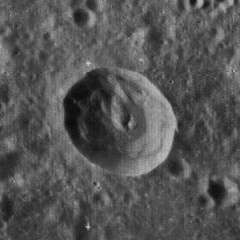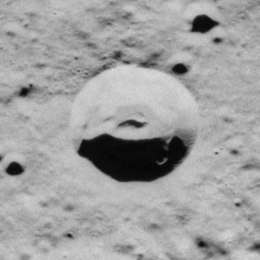Izsak (crater)
Izsak is a small lunar impact crater that is located on the Moon's far side, hidden from view from the Earth. It lies about half-way between the walled plains Fermi to the northeast and Milne to the southwest. Due south of Izsak is the larger crater Schaeberle. Izsak is a circular, nearly symmetric crater formation with a sharp-edged rim that has received little erosion. At the midpoint of the interior floor is a small central peak.[1]
 Lunar Orbiter 3 image | |
| Coordinates | 23.3°S 117.1°E |
|---|---|
| Diameter | 30.83 km |
| Depth | Unknown |
| Colongitude | 243° at sunrise |
| Eponym | Imre Izsák |

Oblique Apollo 17 image, facing east
Satellite craters
By convention these features are identified on lunar maps by placing the letter on the side of the crater midpoint that is closest to Izsak.
| Feature | Latitude | Longitude | Diameter | Ref |
|---|---|---|---|---|
| Izsak T | 23.2° S | 114.8° E | 13.04 km | WGPSN |
gollark: Shuffle them around a bit, sort of thing.
gollark: Yes, just edit the stars.
gollark: Did you try under your sofa cushions?
gollark: Did you find some sort of arbitrary graph generator?
gollark: That's kind of the point...
See also
- 1546 Izsák, asteroid
References
- "Izsak (crater)". Gazetteer of Planetary Nomenclature. USGS Astrogeology Research Program.
- Andersson, L. E.; Whitaker, E. A. (1982). NASA Catalogue of Lunar Nomenclature. NASA RP-1097.CS1 maint: ref=harv (link)
- Bussey, B.; Spudis, P. (2004). The Clementine Atlas of the Moon. New York: Cambridge University Press. ISBN 978-0-521-81528-4.CS1 maint: ref=harv (link)
- Cocks, Elijah E.; Cocks, Josiah C. (1995). Who's Who on the Moon: A Biographical Dictionary of Lunar Nomenclature. Tudor Publishers. ISBN 978-0-936389-27-1.CS1 maint: ref=harv (link)
- McDowell, Jonathan (July 15, 2007). "Lunar Nomenclature". Jonathan's Space Report. Retrieved 2007-10-24.CS1 maint: ref=harv (link)
- Menzel, D. H.; Minnaert, M.; Levin, B.; Dollfus, A.; Bell, B. (1971). "Report on Lunar Nomenclature by the Working Group of Commission 17 of the IAU". Space Science Reviews. 12 (2): 136–186. Bibcode:1971SSRv...12..136M. doi:10.1007/BF00171763.CS1 maint: ref=harv (link)
- Moore, Patrick (2001). On the Moon. Sterling Publishing Co. ISBN 978-0-304-35469-6.CS1 maint: ref=harv (link)
- Price, Fred W. (1988). The Moon Observer's Handbook. Cambridge University Press. ISBN 978-0-521-33500-3.CS1 maint: ref=harv (link)
- Rükl, Antonín (1990). Atlas of the Moon. Kalmbach Books. ISBN 978-0-913135-17-4.CS1 maint: ref=harv (link)
- Webb, Rev. T. W. (1962). Celestial Objects for Common Telescopes (6th revised ed.). Dover. ISBN 978-0-486-20917-3.CS1 maint: ref=harv (link)
- Whitaker, Ewen A. (1999). Mapping and Naming the Moon. Cambridge University Press. ISBN 978-0-521-62248-6.CS1 maint: ref=harv (link)
- Wlasuk, Peter T. (2000). Observing the Moon. Springer. ISBN 978-1-85233-193-1.CS1 maint: ref=harv (link)
This article is issued from Wikipedia. The text is licensed under Creative Commons - Attribution - Sharealike. Additional terms may apply for the media files.